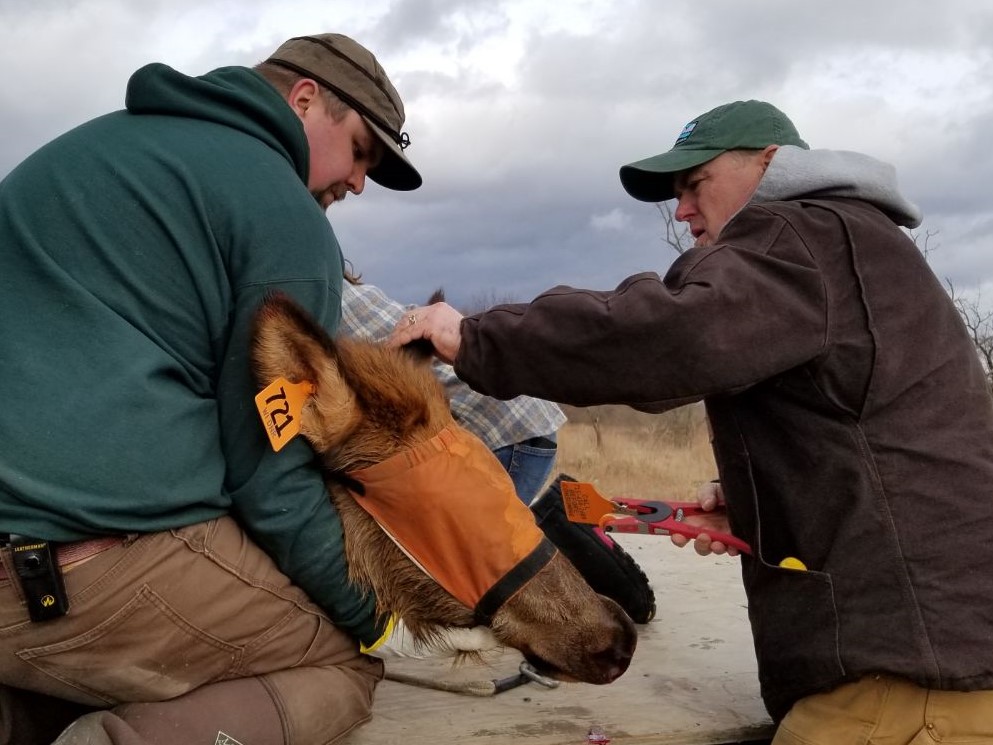Elk Reintroduction
-
Early Reintroduction Efforts
In 1989, the department was directed by the state legislature to explore the feasibility of successfully reintroducing elk, moose and caribou. In the end, it was determined that an elk reintroduction effort could succeed, while reintroductions of moose or caribou likely would not. In 1993, the Wisconsin state legislature authorized the University of Wisconsin-Stevens Point (UWSP) to evaluate the potential for reintroducing elk to the Great Divide District of the Chequamegon-Nicolet National Forest (CNNF) near Clam Lake.
During February 1995, 25 elk were trapped, held in a quarantine facility while undergoing disease testing and transported to the Clam Lake release site. After being held in a pen for an acclimation period, the elk were released into the CNNF on May 17, 1995. Plans were also made to reintroduce elk to the Black River State Forest near Black River Falls of west-central Wisconsin (Jackson County).
Management responsibility of the herd was transferred from UWSP to the DNR in May 1999 after the initial reintroduction study was considered a success. Approximately 40 elk were present in the herd then.
Latest Reintroduction Efforts
In 2013, the legislature exacted s. 29.753, Wis. Stats., which authorized the department to import wild-sourced elk into certain portions of the state, provided certain disease-testing requirements were met. In 2014, the department entered into an agreement with the state of Kentucky to procure, relocate and release as many as 150 wild elk over a period of up to 5 years. The plan involved dividing these animals into two areas of the state, splitting the 150 elk between the existing Clam Lake Herd and establishing a new herd in eastern Jackson County (Black River Herd). The first relocation of elk under this agreement occurred in Jackson County in 2015 and 2016 with 73 elk released. In the years of 2017 and 2019, 91 elk were released on the Flambeau River State Forest (FRSF), near the town of Winter in southeast Sawyer County to supplement the genetic variation and herd numbers within the Clam Lake population. Details are available in an April 3, 2019 press release [PDF]. The elk completed their required quarantine and acclimation period and were released in late August.
Health Monitoring Of Translocated Elk
The DNR worked with the Department of Agriculture, Trade, and Consumer Protection (DATCP) and the United States Department of Agriculture, Cervid Health program (USDA) to establish the necessary transport and importation testing protocols. The outcome was a robust testing protocol that required the elk be held in quarantine for a minimum of 120 days. Multiple rounds of whole-herd testing would occur during quarantine. Each year, the testing protocol was evaluated by these agencies, including the results of previous years’ tests and any data from necropsies (the animal equivalent to an autopsy) of translocated elk.
Additional diseases that may be of concern to both wildlife and domestic animals within the state were considered while making these protocols. Testing for bovine tuberculosis and Brucella abortus were required, as well as an extensive risk assessment that evaluated the possibility of chronic wasting disease in the region of Kentucky where elk were being translocated from. In addition, the DNR tested for diseases that primarily affect wildlife or, in some cases, primarily affect domestic animals and can spill over into wildlife, including bovine viral diarrhea virus, bluetongue and epizootic hemorrhagic disease. A complete blood count (with an evaluation of both the red and white blood cells) was also required, as an extra layer of protection.
Before translocation, the elk were also treated with anthelmintics to reduce external and internal parasite loads as much as biologically possible. The surveillance data and testing requirements used during the translocation are below.
Surveillance and Testing Requirements for Interstate Transport of Wild Caught Cervids [PDF]
2019 Translocation Documents
- 2019 elk translocation summary [PDF]
- Kentucky/Wisconsin Interstate Movement of Wild Cervids signed agreement [PDF]
- CWD Sampling in Kentucky 2002-2017 [PDF]
- 2016 Kentucky CWD Cervid Risk Assessment [PDF]
- 2016-2017 Kentucky CWD Sampling Map [PDF]
- 2017 Kentucky CWD Cervid Risk Assessment [PDF]
- 2017-2018 Kentucky CWD Sampling Map [PDF]

